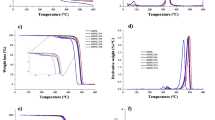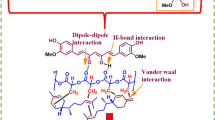Abstract
An active packaging based on the composite film was developed by incorporation of oregano oil as an antimicrobial agent into a cellulose acetate/polycaprolactone diol blend (CA/PCL-diol). A novel plasticizer based on polyethylene terephthalate (PET) glycolysis product (bis(hydroxyethyl terephthalate)) and tartaric acid was synthesized and its influence on the structural, surface, mechanical, barrier, and thermal properties were investigated. The obtained results have shown that plasticizer also has a compatibilizing effect, improving the miscibility of polymers in a blend. A sample with the optimal amount of plasticizer (30 wt%), as well as the best mechanical and barrier properties, was used for the preparation of series with different amounts of oregano oil (3, 6, and 9 wt%). The synthesized azo dye—5-(4-bromo-phenyl azo)-3-amido-6-hydroxy-4-methyl-2-pyridone, soluble in acetone, as well as a blend and plasticizer, has been shown as an adequate one for this composition, due to its ability to achieve a good pigmentation in a low amount (0.3 wt% per polymer blend weight), to absorb UV light, and decrease the aging of the material. Contemporary lifestyle has imposed a need for ready-to-eat (RTE) meals which saves consumers time. RTE food packaging should meet certain requirements such as the ability to prolong shelf-life and preserve the freshness of the food product, and at the same time to make a minimal amount of waste after usage, considering the fact that it is mostly single-use plastic food packaging. Optimal mechanical properties, biodegradability, and additional functions make these films suitable for the packaging of ready-to-eat (RTE) food such as fresh salad.












Similar content being viewed by others
Data availability
The datasets generated during and/or analyzed during the current study are available from the corresponding author on reasonable request.
Abbreviations
- PET:
-
Polyethylene terephthalate
- CA:
-
Cellulose acetate
- PCL-diol:
-
Polycaprolactone diol
- BHET:
-
Bis(2-hydroxyethyl) terephthalate
- TA:
-
Tartaric acid
- GTT:
-
Glycerol tritartarate
- BHETTA:
-
Bis(2-hydroxyethyl) terephthalate/tartaric acid-based ester
- EB:
-
Elongation at break
References
Arienzo A, Murgia L, Fraudentali I, Gallo V, Angelini R, Antonini G (2020) Microbiological quality of ready-to-eat leafy green salads during shelf-life and home-refrigeration. Foods 9:1421–1432. https://doi.org/10.3390/foods9101421
ASTM International, ASTM 96 standard for cup method water vapor permeability testing, 2017. https://www.astm.org/e0096-00e01.html
Aziz MS, El-Mallah HM, Mansour AN (2009) Optical properties of azo dye (1-phenylazo-2-naphthol) thin films. Eur Phys J C 48:20401. https://doi.org/10.1051/epjap/2009137
De Lima JA, Augusto Pinotti C, Felisberti MI, Do Carmo Gonçalves M (2021) Morphology and mechanical properties of nanocomposites of cellulose acetate and organic montmorillonite prepared with different plasticizers. J Appl Polym Sci 24:4628–4635. https://doi.org/10.1002/app.35517
Environmental Protection Agency (2020) Advancing sustainable materials management: 2018 fact sheet assessing trends in materials generation and management in the United States. https://www.epa.gov/
Erceg T, Vukic N, Sovljanski O, Stupar A, Sergelj V, Acimovic M, Balos S, Ugarkovic J, Suput D, Popovic S, Rakic S (2022) Characterization of films based on cellulose acetate/poly(caprolactone diol) intended for active packaging prepared by green chemistry principles. ACS Sustain Chem Eng 10:9141–9154. https://doi.org/10.1021/acssuschemeng.2c02009
Fernandes FG, Grisi CVB, da Costa AR, Botrel DA, de Sousa S (2022) Active cellulose acetate-oregano essential oil films to the conservation of hamburger buns: antifungal, analyzed sensorial and mechanical properties. Packag Technol Sci 35:175–182. https://doi.org/10.1002/pts.2618
Ghosal K, Nayak C (2020) Recent advances in the chemical recycling of polyethylene terephthalate waste into value-added products for sustainable coating solutions—hope vs hype. Mater Adv 3:1974–1992. https://doi.org/10.1039/D1MA01112J
Gomes V, Pires AS, Mateus N, de Freitas V, Cruz L (2022) Pyranoflavylium-cellulose acetate films and the glycerol effect towards the development of pH-freshness smart label for food packaging. Food Hydrocoll 127:107501. https://doi.org/10.1016/j.foodhyd.2022.107501
Gonçalves SM, dos Santos DC, Motta JFG, dos Santosa RR, Chávez DWH, Ramos de Melo N (2019) Structure and functional properties of cellulose acetate films incorporated with glycerol. Carbohydr Polym 209:190–197. https://doi.org/10.1016/j.carbpol.2019.01.031
Herniou-Julien C, Mendieta JR, Gutiérrez TJ (2019) Characterization of biodegradable/non-compostable films made from cellulose acetate/corn starch blends processed under reactive extrusion conditions. Food Hydrocoll 89:67–79. https://doi.org/10.1016/j.foodhyd.2018.10.024
Kamala K, Kumar VP (2018) Food products and food contamination microbial contamination and food degradation. Handb Food Bioeng. https://doi.org/10.1016/B978-0-12-811515-2.00001-9
Mastromatteo M, Mastromatteo M, Conte A, Del Nobile MA (2010) Advances in controlled release devices for food packaging applications. Trends Food Sci Technol 21(12):591–598
Miranda JM, Jorge F, Dominguez L, Cepeda A, Franco CM (2010) In vitro growth inhibition of foodborne pathogens and food spoilage microorganism by vitamin K5. Food Bioprocess Technol 4(6):1060–1065. https://doi.org/10.1007/s11947-010-0413-6
Muriel-Galet V, Cerisuelo JP, López-Carballo G, Lara M, Gavara R, Hernández-Muñoz P (2012) Development of antimicrobial films for microbiological control of packaged salad. Int J Food Microbiol 157(2):195–201. https://doi.org/10.1016/j.ijfoodmicro.2012.05.002
Nejad MH, Ganster J, Volkert B (2010) Starch esters with improved mechanical properties through melt compounding with nanoclays. J Appl Polym Sci 118:503–510. https://doi.org/10.1002/app.32312
PET Packaging Market|2022-27|Industry Share, Size, Growth—Mordor Intelligence. https://www.mordorintelligence.com/industry-reports/pet-packaging-market. Accessed 18 May 2022
Pereira NRL, Lopes B, Fagundes IV, Moraes FM, Dal Pont MF, Parma GOC, Zepon MZ, Magnago RF (2022) Bio-packaging based on cellulose acetate from banana pseudostem and containing Butia catarinensis extracts. Int J Biol Macromol 194:32–41. https://doi.org/10.1016/j.ijbiomac.2021.11.179
Porobić S, Krstić A, Jovanović D, Ladjarevic J, Dj K, Mijin D, Marinovic-Cincovic M (2019) Synthesis and thermal properties of arylazo pyridone dyes. Dyes Pigm 170:107602. https://doi.org/10.1016/j.dyepig.2019.107602
Porobić S, Božić B, Dramićanin M, Vitnik V, Vitnik Ž, Marinović-Cincović M, Mijin D (2020) Absorption and fluorescence spectral properties of azo dyes based on 3-amido-6-hydroxy-4-methyl-2-pyridone: Solvent and substituent effects. Dyes Pigm 175:108139. https://doi.org/10.1016/j.dyepig.2019.108139
Rabiej SA (1991) Comparison of two X-ray diffraction procedures for crystallinity determination. Eur Polym J 27(9):947–954. https://doi.org/10.1016/0014-3057(91)90038-P
Rodríguez FJ, Torres A, Peñaloza Á, Sepúlveda H, Galotto MJ, Guarda A, Bruna J (2014) Development of an antimicrobial material based on a nanocomposite cellulose acetate film for active food packaging. Food Addit Contam Chem Anal Control Expo Risk Assess 31:342–353. https://doi.org/10.1080/19440049.2013.876105
Sadeghi B, Marfavi Y, Ali Akbari R, Kowsari E, Ajdari FB, Ramakrishna S (2021) Recent studies on recycled PET fibers: production and applications: a review. Mater Circular Economy 3(4):1–9. https://doi.org/10.1007/s42824-020-00014-y
Salam A, Qamar Khan M, Hassan T, Hassan N, Nazir A, Tanveer Hussain T, Azeem M, Soo Kim I (2020) In-vitro assessment of appropriate hydrophilic scaffolds by co-electrospinning of poly(1,4 cyclohexane isosorbide terephthalate)/polyvinyl alcohol. Sci Rep 10:19751. https://doi.org/10.1038/s41598-020-76471-x
Sharma A, Mandal T, Goswami S (2021) Fabrication of cellulose acetate nanocomposite films with lignocellulosic nanofiber filler for superior effect on thermal, mechanical, and optical properties. Nano-Struct Nano-Obj 25:100642. https://doi.org/10.1016/j.nanoso.2020.100642
Sirolli L, Patrignani F, Serrazanetti DI, Chiavari C, Benevelli M, Grazia L, Lanciotti R (2017) Survival of spoilage and pathogenic microorganisms on cardboard and plastic packaging materials. Front Microb 8:1–10. https://doi.org/10.3389/fmicb.2017.02606
Sung S-Y, Sin LT, Tee T-T, Bee S-T, Rahmat AR, Rahman WAW, Vikhraman M (2013) Antimicrobial agents for food packaging applications. Trends Food Sci Technol 33(2):110–123. https://doi.org/10.1016/j.tifs.2013.08.001
Technical information for Cellulose Acetate Plasticization, Daicel Corporation, https://www.daicel.com/cell_ac/en/assets/pdf/detail_2021.pdf?210331
Vasconcelos LA, Reis LCB, Dias ÊR, Camilloto GP, Branco A (2021) Characterization of a flavonol-rich antioxidant fraction from Spondias purpurea L. pulp and the effect of its incorporation on cellulose acetate-based film. J Sci Food Agric 101:3270–3279
Wang Y, Qian H (2021) Phthalates and their impacts on human health. Healthcare 9:603–702. https://doi.org/10.3390/healthcare9050603
Wang Q, Chen W, Zhu W, McClements DJ, Liu X, Liu F (2022) A review of multilayer and composite films and coatings for active biodegradable packaging. Npj Sci Food 6(18):1–16. https://doi.org/10.1038/s41538-022-00132-8
Wunderlich B (1990) Thermal analysis. Academic Press, Boca Raton, pp 417–431
Zhong Y, Godwin P, Jin Y, Xiao H (2020) Biodegradable polymers and green-based antimicrobial packaging materials: a mini-review. Adv Ind Eng Polym Res 3(1):27–35. https://doi.org/10.1016/j.aiepr.2019.11.002
Acknowledgments
The authors thank the Ministry of Science, Technological Development and Innovation, Republic of Serbia, Project Number 451-03-47/2023-01/200134 and Provincial Secretariat for Higher Education and Scientific Research of AP Vojvodina [142-451-3106/20222-01].
Funding
All expenses (chemical analysis, materials) were funded by ourselves and funds provided by the Ministry of Science, Technological Development and Innovation, Republic of Serbia, and Provincial Secretariat for Higher Education and Scientific Research of AP, Republic of Serbia.
Author information
Authors and Affiliations
Contributions
The manuscript was written through the contributions of all authors. All authors have approved the final version of the manuscript.
Corresponding author
Ethics declarations
Conflict of interest
The authors declare no competing financial or any other interest relevant to the content of this article.
Ethical approval
This paper does not contain any studies with human participants or animals performed by any of the authors.
Consent to participate
Informed consent was obtained from all individual participants included in the study.
Consent for publication
I along with coauthors of this paper give my consent for the publication of identifiable details, including Supporting material to be published in Cellulose. Coauthors have seen and been given the opportunity to read both the Supporting material and the Article (as attached) to be published.
Additional information
Publisher's Note
Springer Nature remains neutral with regard to jurisdictional claims in published maps and institutional affiliations.
Supplementary Information
Below is the link to the electronic supplementary material.
Rights and permissions
Springer Nature or its licensor (e.g. a society or other partner) holds exclusive rights to this article under a publishing agreement with the author(s) or other rightsholder(s); author self-archiving of the accepted manuscript version of this article is solely governed by the terms of such publishing agreement and applicable law.
About this article
Cite this article
Erceg, T., Vukić, N., Šovljanski, O. et al. Preparation and characterization of biodegradable cellulose acetate-based films with novel plasticizer obtained by polyethylene terephthalate glycolysis intended for active packaging. Cellulose 30, 5825–5844 (2023). https://doi.org/10.1007/s10570-023-05240-6
Received:
Accepted:
Published:
Issue Date:
DOI: https://doi.org/10.1007/s10570-023-05240-6




